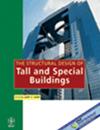Finite element simulation and strength evaluation on innovative and traditional composite shear wall systems
IF 1.3
3区 工程技术
Q3 CONSTRUCTION & BUILDING TECHNOLOGY
引用次数: 0
Abstract
Summary Composite shear wall (CSW) system, which consists of a steel boundary frame and a steel panel with a reinforced concrete (RC) panel attached to one side of it using bolts, is commonly used in mid‐ to high‐rise buildings. In a CSW system, RC panel functions as out‐of‐plane restraint to prevent overall buckling of steel panel, thereby enhancing system behavior. However, for a traditional CSW system, the RC panel is in direct contact with the steel boundary frame. The RC panel tends to crush under seismic loading, thereby leading to a weak constraint to steel panel buckling. The innovative CSW system, where a gap remained between steel boundary frame and RC panel, demonstrated better cyclic behavior than the traditional CSW system. Current studies aimed to investigate cyclic behavior, parameter effects, and determination of RC panel stiffness of CSW systems. In this paper, detailed FE models were developed for simulating cyclic behavior of both innovative and traditional CSW systems and validated by test results. FE models accurately predicted lateral load‐drift response and failure patterns of both innovative and traditional CSW systems. System failure patterns and load‐carrying mechanism of RC panels were discussed. The effects of major parameters, including steel panel thickness, RC panel thickness, ratio of bolt spacing to steel panel thickness, and gap between frame and RC panel, were examined using the validated models. Simulation results indicated that steel panel thickness contributed to increase the lateral strength and initial stiffness of both innovative and traditional CSW systems. Although RC panel thickness, ratio of bolt spacing to steel panel thickness, and gap between frame and RC panel had negligible effects on system strength and stiffness, they should also be carefully designed to ensure local stability of the steel panel and system ductility. Formulations were proposed for predicting the lateral strength of both innovative and traditional CSW systems. The average difference between calculated and test/simulated lateral strength was less than 3%.创新与传统组合剪力墙体系的有限元模拟与强度评价
复合剪力墙(CSW)系统通常用于中高层建筑,它由钢边界框架和钢板组成,一侧用螺栓连接钢筋混凝土(RC)板。在CSW系统中,RC板作为面外约束,防止钢板整体屈曲,从而提高系统性能。然而,对于传统的CSW系统,RC面板是直接接触钢边界框架。钢筋混凝土面板在地震荷载作用下容易发生压碎,从而导致对钢板屈曲的约束较弱。创新的CSW体系在钢边界框架和RC面板之间留有间隙,表现出比传统CSW体系更好的循环性能。目前的研究旨在探讨循环行为,参数的影响,并确定混凝土混凝土系统面板的刚度。本文建立了详细的有限元模型来模拟创新和传统CSW系统的循环行为,并通过试验结果进行了验证。有限元模型准确地预测了创新和传统CSW系统的横向载荷漂移响应和失效模式。讨论了RC板的系统失效模式和承载机理。采用验证模型考察了主要参数的影响,包括钢板厚度、钢筋混凝土板厚度、螺栓间距与钢板厚度之比以及框架与钢筋混凝土板之间的间隙。仿真结果表明,钢板厚度对创新和传统CSW系统的侧向强度和初始刚度都有一定的提高作用。尽管RC板厚度、螺栓间距与钢板厚度之比、框架与RC板之间的间隙对系统强度和刚度的影响可以忽略不计,但也应仔细设计,以确保钢板的局部稳定性和系统的延性。提出了用于预测创新和传统CSW系统横向强度的公式。计算和试验/模拟的横向强度之间的平均差异小于3%。
本文章由计算机程序翻译,如有差异,请以英文原文为准。
求助全文
约1分钟内获得全文
求助全文
来源期刊
CiteScore
5.30
自引率
4.20%
发文量
83
审稿时长
6-12 weeks
期刊介绍:
The Structural Design of Tall and Special Buildings provides structural engineers and contractors with a detailed written presentation of innovative structural engineering and construction practices for tall and special buildings. It also presents applied research on new materials or analysis methods that can directly benefit structural engineers involved in the design of tall and special buildings. The editor''s policy is to maintain a reasonable balance between papers from design engineers and from research workers so that the Journal will be useful to both groups. The problems in this field and their solutions are international in character and require a knowledge of several traditional disciplines and the Journal will reflect this.
The main subject of the Journal is the structural design and construction of tall and special buildings. The basic definition of a tall building, in the context of the Journal audience, is a structure that is equal to or greater than 50 meters (165 feet) in height, or 14 stories or greater. A special building is one with unique architectural or structural characteristics.
However, manuscripts dealing with chimneys, water towers, silos, cooling towers, and pools will generally not be considered for review. The journal will present papers on new innovative structural systems, materials and methods of analysis.

 求助内容:
求助内容: 应助结果提醒方式:
应助结果提醒方式:


